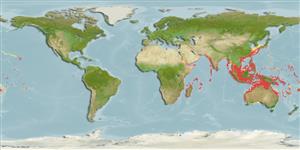Common names from other countries
>
Carangaria/misc (Various families in series Carangaria) >
Polynemidae (Threadfins)
Etymology: Polydactylus: Greek, poly = a lot of + greek, daktylos = finger (Ref. 45335).
Issue
Genus Eschmeyer, pers. comm.
Environment: milieu / climate zone / depth range / distribution range
экология
морской; солоноватоводный демерсальный; пределы глубины ? - 122 m (Ref. 57343). Tropical; 37°N - 35°S, 22°E - 148°W (Ref. 57343)
Indo-Pacific: East Africa to French Polynesia, north to Japan, south to Australia. Has not been collected from the Red Sea or Persian Gulf (Ref. 57343).
Size / Вес / Возраст
Maturity: Lm ? range ? - ? cm
Max length : 45.0 cm SL самец/пол неопределен; (Ref. 57343); common length : 30.0 cm TL самец/пол неопределен; (Ref. 30573); наибольший вес (опубликованные данные): 1.7 kg (Ref. 40637)
колючие лучи спинного плавника (общее число) : 9; членистые (мягкие) лучи спинного плавника (общее число) : 13; колючие лучи анального плавника: 2; членистые (мягкие) лучи анального плавника: 11 - 12. Golden, dusky olive brown above, scale rows each with a dark line; fins dusky (Ref. 5492). Body with 7 or 8 prominent dark stripes along the longitudinal scale rows above lateral line and 7-9 faint stripes below. Pectoral fin rays unbranched; 4th or 5th pectoral filament longest, 22-40% of SL. Posterior margin of maxilla reaching to (or slightly extending beyond) level of posterior margin of adipose eyelid. Lower tip of 7th proximal pterygiophore of 1st dorsal fin directed backwards. Lateral squamation on caudal fin unbranched (Ref. 40970).
Occur over muddy bottoms of the continental shelf (Ref. 4340), from estuaries to coastal beaches and to relatively deep waters (less than 122 m) (Ref. 57343). Forms loosely-associated schools (Ref. 57343). Feeds on small crustaceans, fishes and other benthic organisms (Ref. 30573). Fish of 12 cm can be caught in large numbers (Ref. 9685).
Life cycle and mating behavior
Maturities | размножение | Spawnings | Egg(s) | Fecundities | личинки
Motomura, H., 2004. Threadfins of the world (Family Polynemidae). An annotated and illustrated catalogue of polynemid species known to date. FAO Spec. Cat. Fish. Purp. Rome: FAO. 3:117 p. (Ref. 57343)
Статус Красного Списка МСОП (Ref. 130435)
CITES (Ref. 128078)
Not Evaluated
Угроза для людей
Harmless
Использование человеком
рыболовство: коммерческий; аквакультура (рыбоводство): коммерческий; объект спортивного рыболовства: да
дополнительная информация
инструменты
Специальные отчеты
Скачать в формате XML
ресурсы в Интернет
Estimates based on models
Preferred temperature (Ref.
115969): 23.5 - 29.1, mean 28 (based on 2216 cells).
Phylogenetic diversity index (Ref.
82804): PD
50 = 0.5000 [Uniqueness, from 0.5 = low to 2.0 = high].
Bayesian length-weight: a=0.00851 (0.00489 - 0.01483), b=3.07 (2.91 - 3.23), in cm Total Length, based on LWR estimates for this species & (Sub)family-body (Ref.
93245).
Trophic level (Ref.
69278): 3.6 ±0.50 se; based on food items.
устойчивость к внешним воздействиям (Ref.
120179): высокий, минимальное время удвоения популяции до 15 месяцев (Preliminary K or Fecundity.).
Fishing Vulnerability (Ref.
59153): Moderate vulnerability (42 of 100).
